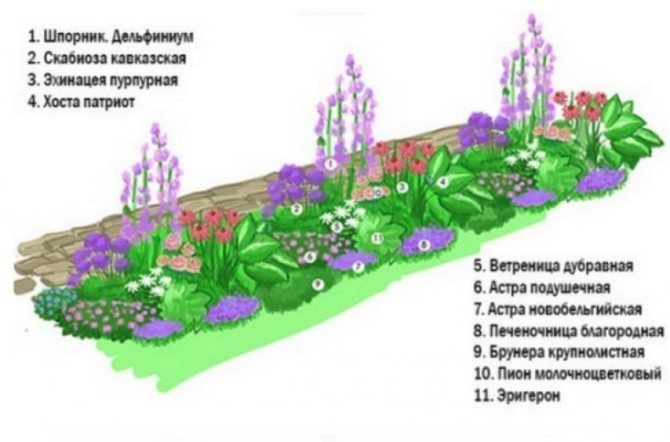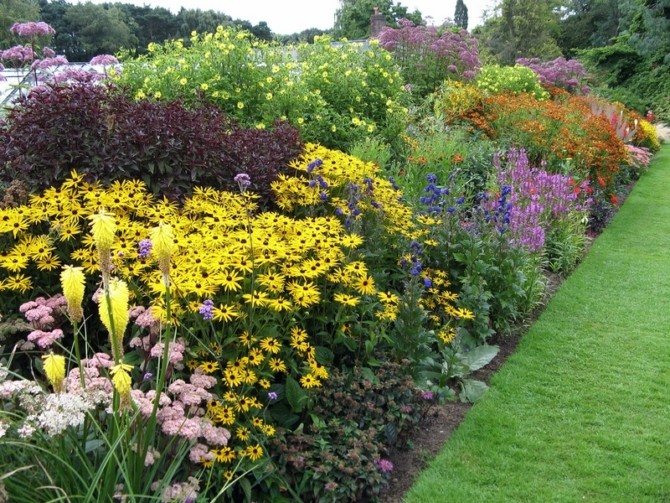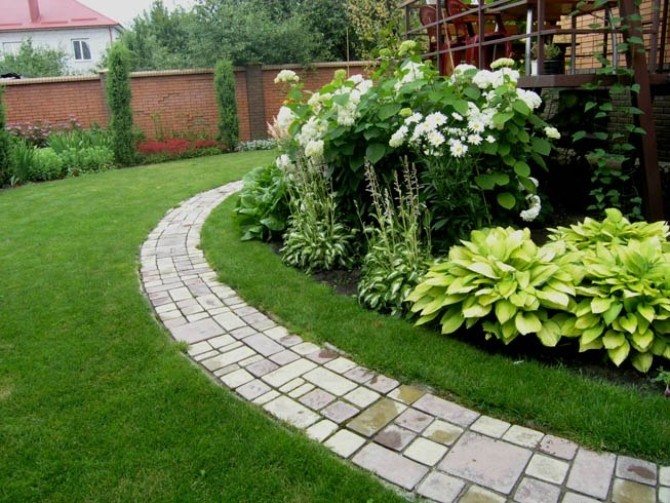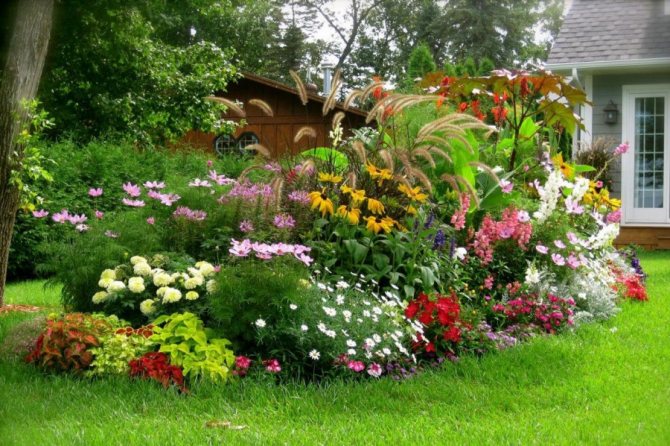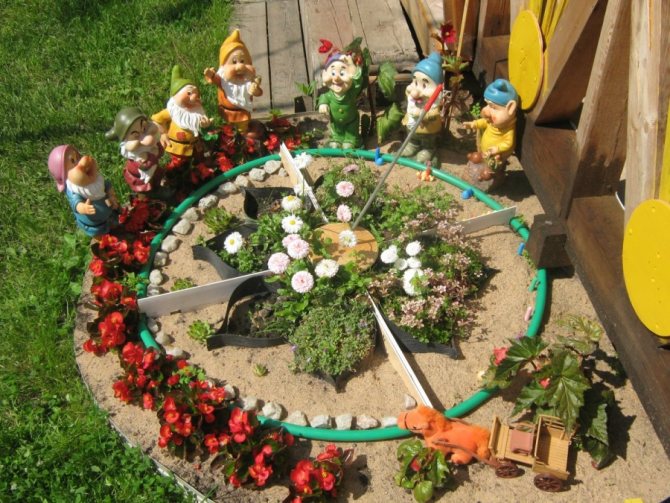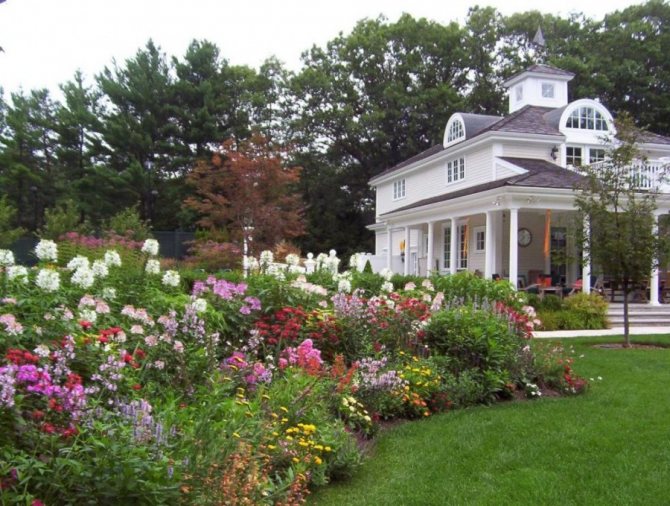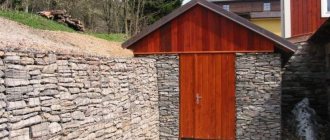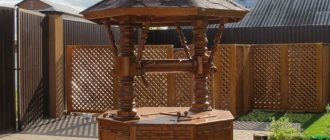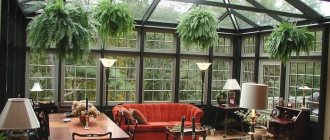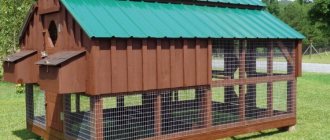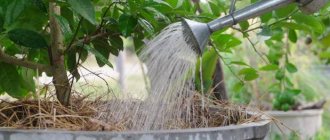For every gardener, a flower bed or flower garden takes first place. Having a summer cottage, plant flowering plants, they will not only decorate the area, but also bring a lot of fragrant pleasure.
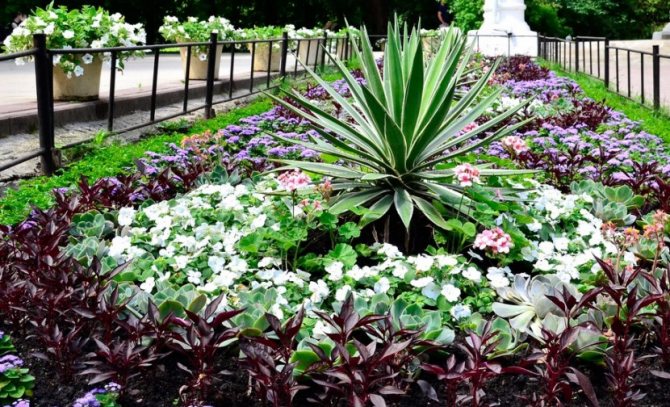
In our article, everyone will find for themselves new ideas on how to make a beautiful flower bed.
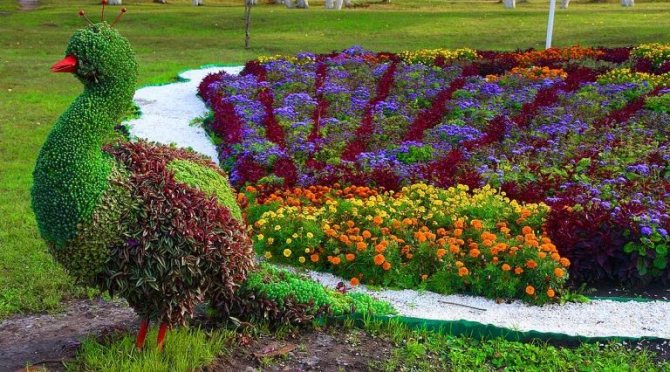

The principles of forming a flower garden
Before proceeding with the improvement of the territory of the dacha, it is necessary to familiarize yourself with the fundamental principles of flower bed design.


Compliance with the recommendations on growing conditions, knowledge of the timing of flowering and the rules for the formation of various types of flower beds will help to avoid annoying mistakes. Novice flower growers should take into account the advice of experienced summer residents:
- Initially, the shape and size of the flower bed is determined, the prevailing color range. The schemes proposed below or compiled independently will help to harmoniously distribute the floral mix. Advice! It is better to practice on the design of a flower garden of perennials, unpretentious plants do not need complex care
- You should not overfill the flower bed, the plants will gradually grow on their own. Their excess will provoke a deterioration in flowering and the decorative effect of the site will be lost.
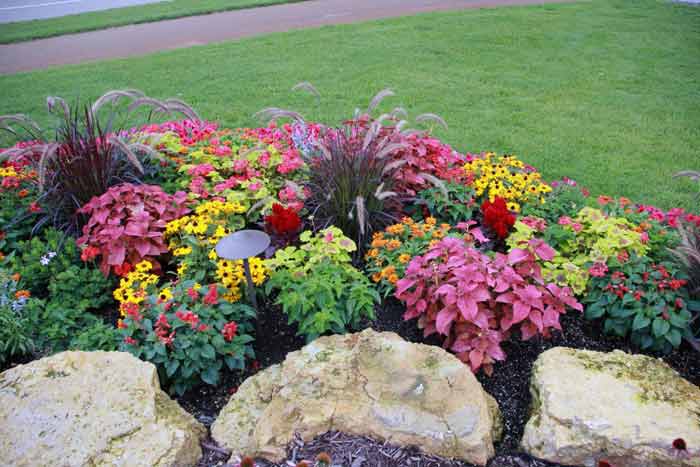

- Flowers planted in a flowerbed in a group are always better eye-catching than single specimens.


- The most harmonious look at the dacha flower beds, pleasing with a riot of colors from early spring to late autumn. Therefore, when drawing up a diagram of perennials, be sure to take into account the timing of flowering plants. Annuals will help to fill in the interim periods.
- The choice of the scheme and the formation of a flower garden in the country is carried out taking into account the characteristics of the soil and the parameters of illumination. For one flower bed, plants are usually selected with the same conditions of detention.


- It is important to correctly complete the color palette of the flower bed. Do not get carried away with flashy variegation. It is better to complement the bright representatives of the flora with plants with white or pastel colors.
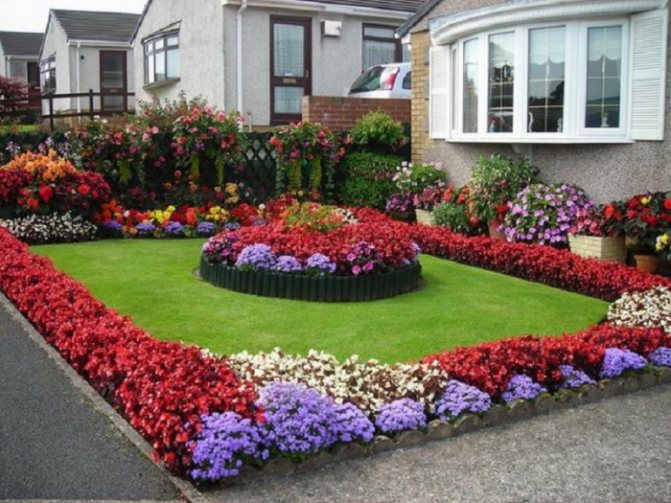

The shape and location of the flower bed in the country affects the choice of plant height. A strict and narrow bed is often filled with plants with the same height within 15-40 cm. For a round flower garden, a flower bed scheme with tall plants in the center is suitable, then medium-sized specimens are planted, the outer circle is formed by undersized species. A mixborder near a fence or a building wall is also equipped with plants of various heights, but according to a different principle: in the background there are flower beds - tall flowers or a neat shrub with a gradual transition to medium-sized, and then stunted species.
- The following mixborder of tagetis, sedum, chamomile, millet, budley and sage will harmoniously complement the recreation area:
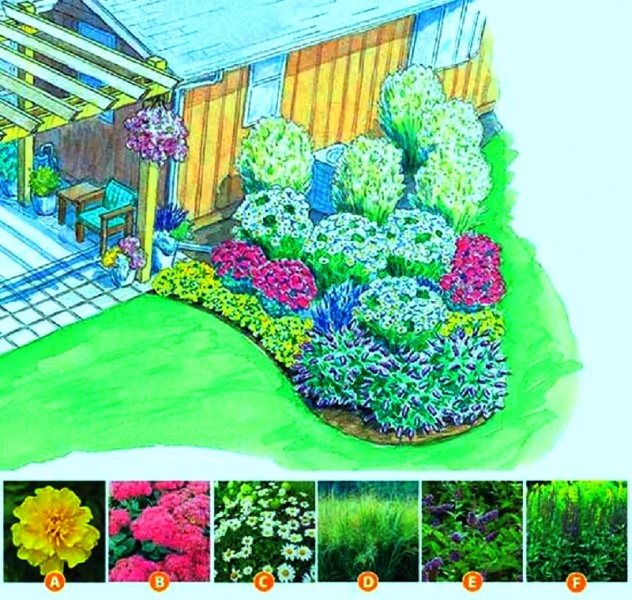

- Or an option for arranging a pergola containing heuchera, lilac, space, baptisia, hellebore and dogwood:
For beginners, in order to arrange a harmonious flower garden in the country with their own hands, they should first draw up or select a suitable scheme indicating the landing zone for each species. This will facilitate the calculation of the need for planting material and the entire process of landscaping the flower garden.
Perennial spring flowers for a flower bed
Snowdrop (Galanthus)
This flower is popular with flower growers due to flowering when there is still snow around. The plant has a small height of 12-15 centimeters with two leaves. The wild species blooms early in April, as soon as the snow melts and even against the background of snow.There are also garden species that can be successfully grown; the plant loves areas that are not exposed to direct sunlight.
Snowdrop
It is not whimsical to soils, but does not like excessively humid places. Since the garden snowdrop species originated from wild plants, they are very hardy plants.
Reproduction takes place in two ways:
- Seeds that are sown in the summer without pretreatment after being harvested from the plants. But this path is long, due to the fact that the first shoots will appear only in the spring of next year. After the young plants have strengthened, they are transplanted to a permanent place.
- Bulbs: they are dug up in the second half of summer, the baby is separated, dried and planted in a permanent place at the beginning of autumn. The planting distance for large bulbs is 7-10 centimeters from each other, and small bulbs are planted at a distance of 3-5 centimeters from each other.


Scylla (blue snowdrop)
A plant of the lily family, for the earlier flowering and blue color of the flowers, it got its name. The plant has bright green and wide leaves, which are arranged in rosettes of 3-4 pieces and several beautiful blue flowers.
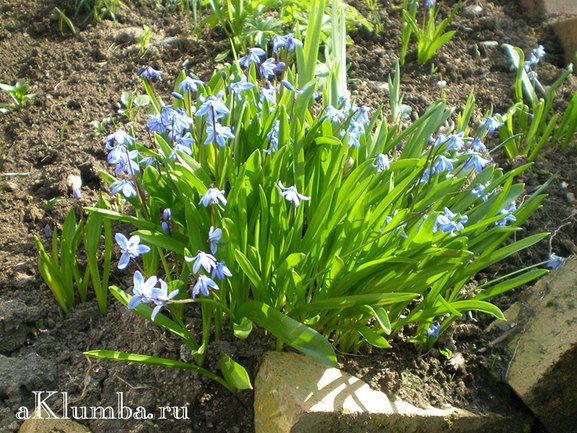

Scilla
Flowers prefer loose and semi-darkened soils. They tolerate winter well, reproduce like a snowdrop (seeds and bulbs). When sowing seeds, seedlings appear only in the 3-5th year. Great for forcing for early flowering in mid-winter.
Muscari (Mouse Hyacinth)
A beautiful plant from the lily family. Flowers of different colors: blue, white, lilac-blue. Frost-resistant, grows in one place for 4-5 years. It propagates like all bulbous plants by a baby, less often by seeds, since seedlings appear only after a few years.
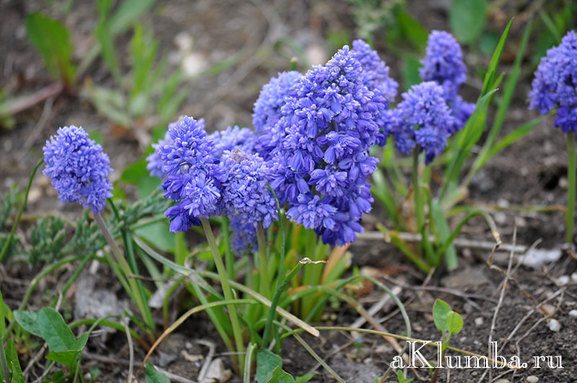

Muscari
Bulbs are planted at the end of summer, flowers appear on the plants the next year. It is widely used in forcing.
Crocus
It is one of the most common early flowering plants. There are crocuses that bloom in early spring, and there are those that bloom in late autumn. Plants are small up to 14 centimeters, flowers have different colors (from white to yellow).
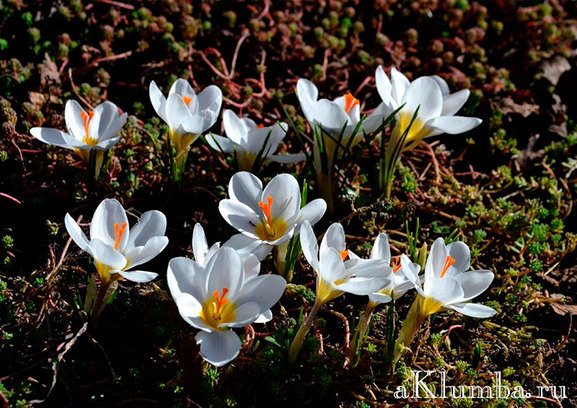

Crocus
A rare feature of the plant is its leaves, which only grow after flowering ends. For reproduction, corms, baby and seeds are used. It lends itself very well to forcing and blooms profusely in winter.
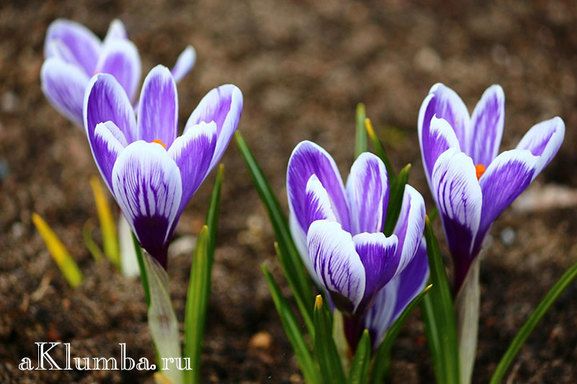

To obtain fresh and beautiful flowers in winter, late autumn into a prepared mixture consisting of two parts of sod land and one part of leaf humus and river sand. After about two months, the crocus blooms.
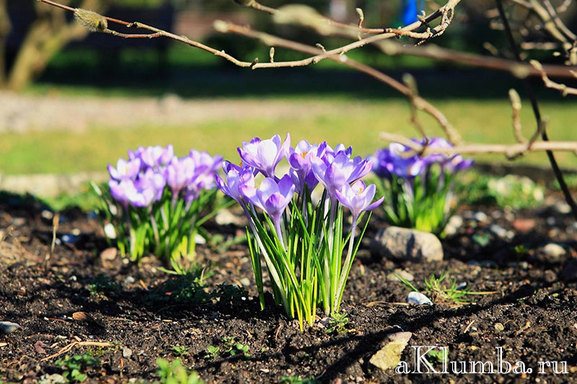

Daffodils
Widespread among flower lovers for early flowering and beautiful, pleasantly smelling flowers. For these flowers, a richly fertilized and well-loosened soil is prepared. The bulbs should be planted in autumn (September-October) at a shallow depth (about 10 cm) and mulched with humus. Bulbs overwinter and bloom profusely in spring.
Daffodils
It mainly reproduces by children (small bulbs), they are taken from large ones at the end of summer, dried and planted in September. Also, like crocuses, they are suitable for winter forcing, it is important not to forget to keep the soil moist at all times.
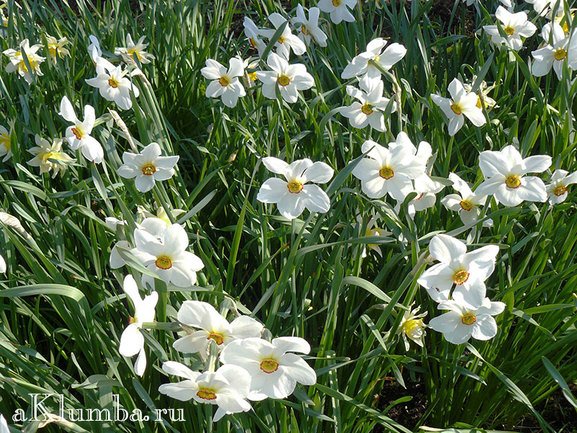

Tulip
Bulbous plant of the lily family. Currently, more than 120 wild types of flowers have been studied and several thousand varieties and hybrids have been bred as garden flowers. Tulips are divided into 4 groups: early blooming, medium blooming, late blooming and wild.
Propagated by seeds or vegetatively. But in practice, propagation by bulbs and babies is used, for this, at the end of summer, when the leaves of the plant are already dry, they dig up the bulbs. They dry well and separate small from large.


Tulips
Bulbs larger than 2 centimeters in diameter can already be used for flowering, smaller ones require one or two years to grow.
Tulips love loose, well-fertilized soils with normal light. These flowers do not like dimly lit places and acidic soils, on which plants will grow poorly and often get sick.
Tulips are the best flowers for indoor distillation. At the end of September, they take the best bulbs and plant them in pots, one bulb each. A soil mixture is prepared from turf soil, mixed with humus and sand.
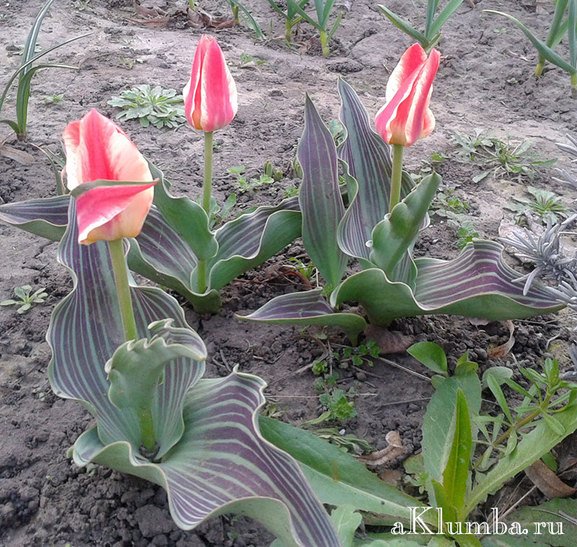

The soil in pots is watered abundantly, and sprinkled with sawdust to retain moisture. Then they are placed in a room with a temperature of no more than 3-7 degrees for 1.5-2 months. After that, the pots are placed on a warm windowsill, and after 25-30 days the plants will bloom. Cut tulip flowers are stored in fresh cold water for a long time, for which they are especially popular in the flower industry.
These flowers for a flower bed are unpretentious both to soil and to care, so even a novice amateur florist can cope with their cultivation.
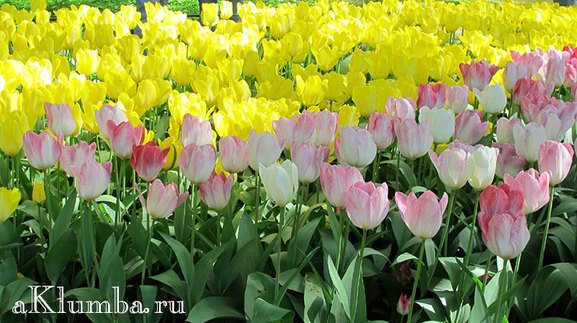

Perennial iris for flower beds
This flower is distinguished by its special grace. It is impossible to look away from its royal beauty and surprisingly sophisticated form. Translated from Greek "iris" means - rainbow. According to the legend, the goddess Irida came to earth to people precisely by the rainbow. These flowers received this name in the 4th century BC.
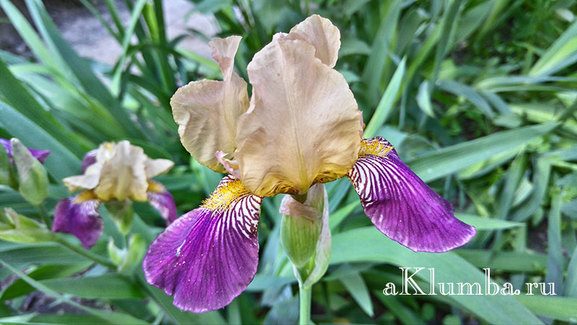

Perennial iris for flower beds
There is a very interesting legend about how the flower spread throughout the earth. Initially, irises grew only in ancient Asia, but the birds that inhabited forests and gardens there spread the seeds of this plant around the world.


The well-known city of Florence received this name only because all its borders were planted with blooming irises.
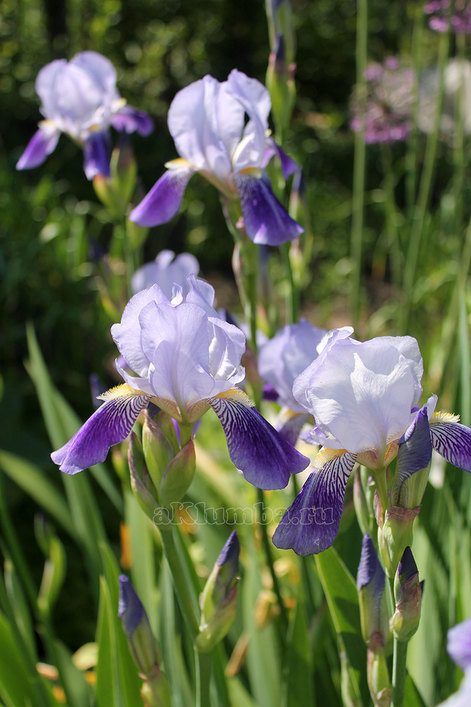

Today there are more than 250 types of irises. They grow on all continents. Only in the latitudes of modern Russia can be counted about 60 species of this flower. Iris is a distant and more ancient relative of gladiolus.
Among all the variety of irises, the most popular are: Siberian, bearded and Japanese species. The marsh type of bright yellow iris is also very popular.
The bearded iris is a very interesting flower. Along the edge of its petal are delicate, colored hairs, which in their appearance very much resemble a beard.
A feature of Siberian irises is their special resistance to low temperatures and not whimsical to growing conditions.
Japanese irises retain their decorative appearance and flowering for the longest time. You can separate them once every seven years, in early autumn or spring.
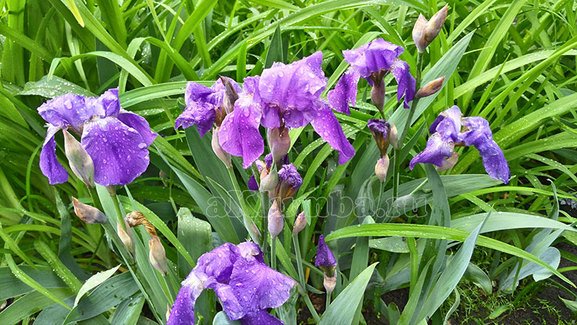

Swamp iris is a wild plant, but it attracts people with its bright yellow color. Marsh iris reproduces by seeds, which, when in the water, are easily localized in new places of growth.
Perennial peony for a flower bed
This amazingly beautiful flower can rightfully be called the king of plants. In addition to its bright color, the peony has a special, very delicate aroma. It cannot be confused with other colors.
Peony perennial
Few people know that the peony is endowed with a deep philosophical meaning. According to the oldest records of Chinese scholars, peonies symbolize the fundamental positions of any person - love and family.
Poppy
These light, seemingly weightless plants attract with their bright and large flowers. Some types of poppy have different color buds. Shades range from pure white to rich purples and violets.
Poppies
The peculiarity of the poppy is the rapidly falling flower petals. Also, the poppy boll gives the largest amount of very small seeds. Their number can reach more than 300 thousand pieces in one flower.
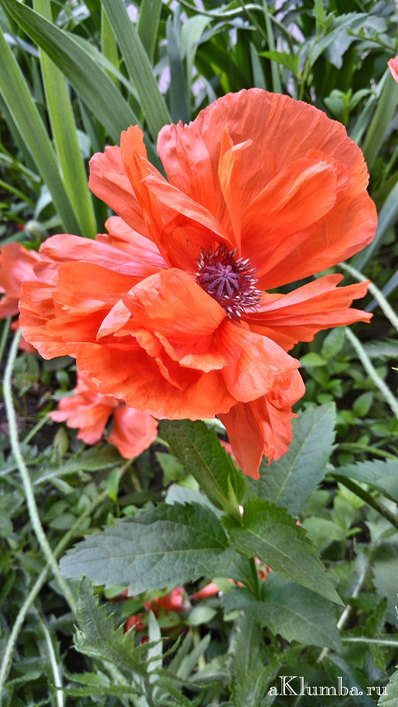

Poppy is widely used both for medicinal purposes and in cooking.Therefore, poppies can very often be seen on personal plots, orchards, vegetable gardens. Due to their unique beauty, poppies are planted in flower beds with a purely decorative function.
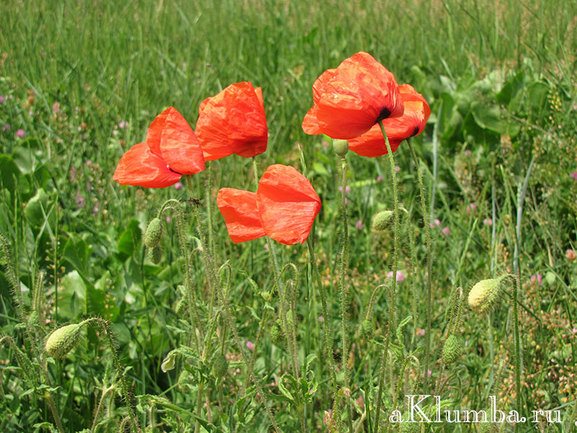

Poppies create wonderful compositions with other flowers. Floral arrangements of poppies of various color shades look interesting.
Poppy has become widespread not only due to its decorative, medicinal and practical properties. Poppies are very unpretentious to care for. It can be planted in any soil, it will delight you with bright flowers for more than one year.
Anemones
These perennial, herbaceous plants are not often found in flower beds or in the garden. However, with their flowers, they are able to decorate any site. Anemones look especially impressive against the background of stones in combination with other plants.


Anemones
Anemone belongs to the buttercup family, and has more than 120 different species. As a rule, this thermophilic plant grows well in the southern temperature zone.
The ancient Greeks called anemones "the daughter of the winds". They believed that the wind helps the flower bud open or close. But of course it is not. In fact, the flowers of the anemone are so delicate that under the influence of the wind, large, but rather fragile petals curl up.
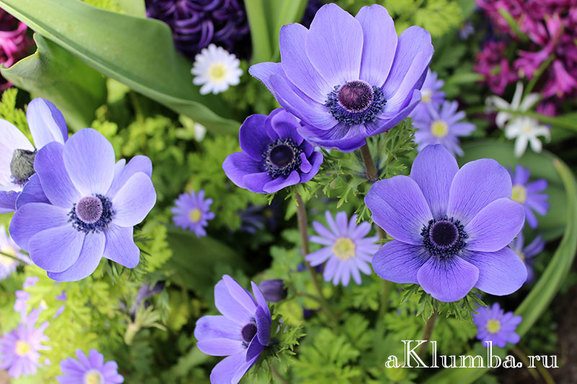

Anemones are quite long plants. Thin stems reach up to 50 cm in height. Depending on the type of flower, the color of the petals and sepals of the plant changes.
Anemones gained popularity due to their long flowering. All summer and autumn they will delight with their color. Anemones create wonderful compositions with shrubs and trees.
Approaching creatively, with love and knowledge of the matter, you can turn any piece of land into a piece of paradise, which will delight with its unfading beauty, color change and vibrant texture. The main thing to remember is that you should not plant everything, choose only what is closer in spirit and mood.
How to choose flowers for a summer residence - expert advice
Read about annual flowers here.
Photo gallery of flowers for a flower bed
Flowering Period Information
Beds of continuous flowering transform the cottage, making the site attractive all season. A key condition in drawing up schemes for such a flower bed is the regular presence of at least one flowering species. For the correct configuration of the scheme, you need to familiarize yourself with the timing of flowering plants:
- Warm March will delight you with snowdrops and crocuses; at the end of the month, pansies may appear in the country.


- The baton in April is taken by: lungwort, daisies, primrose, early tulips and daffodils, liverwort.
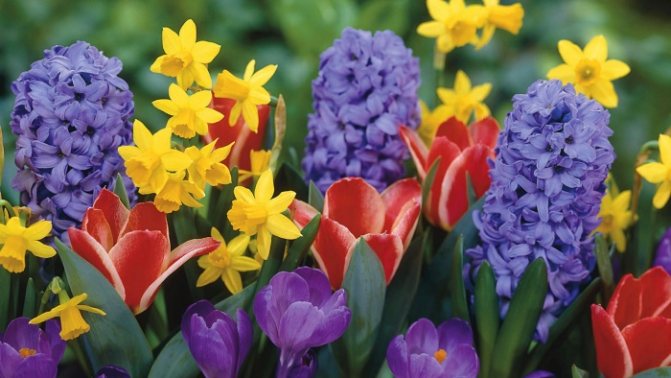

- Bulbous plants dominate the flowerbed in May: hyacinths, daffodils and tulips. In addition to them, the flower garden of the summer cottage will be decorated with decorative onions, lilies of the valley, phlox, forget-me-nots, a bathing suit and other types.
- For June, set aside a place in the flower bed scheme for carnations, peonies, daisies, bells, irises, poppies, lilies. The first summer month is generous with flowering species, a flower garden scheme for a summer cottage may contain petunias, delphiniums, irises, felicia, lupins. The first rosebuds appear, which will delight with flowers until late autumn.
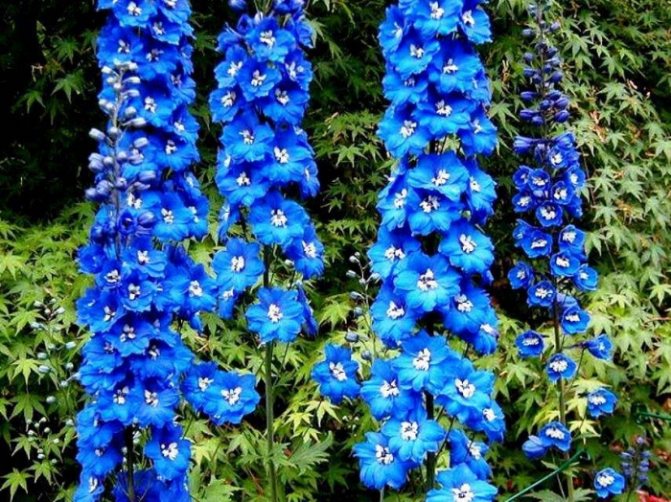

- Midsummer at the dacha will be illuminated by the flowering of daylilies, dahlias, late lilies and phlox. Cannes, nasturtium, cosmea, astilbe will organically complement the flowerbed scheme, and the evening will be filled with the heady aroma of mattiola.
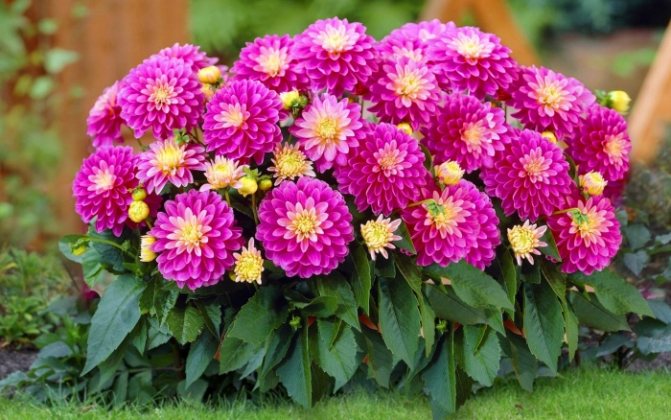

- At the end of summer, the summer cottage continues to be decorated with a flower garden with dahlias, phloxes and astilba, passing the baton to summer chrysanthemums, gladioli, ornamental sunflowers and goldenrod.
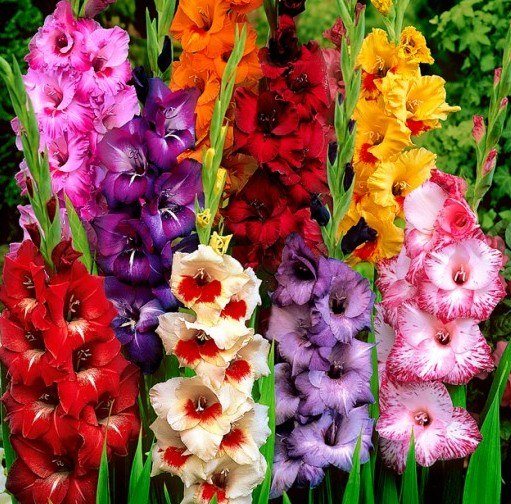

- For September, set aside a place in the flower bed scheme for marigolds, asters, dahlias and chrysanthemums. If you're lucky, daisies, pansies and hybrid roses will bloom a second time.
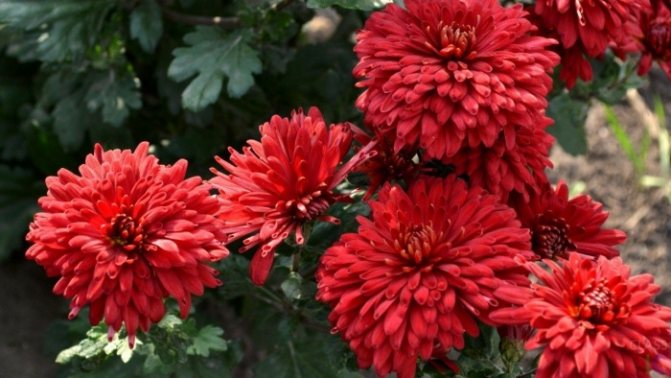

- A stunning spring landscape in the country is depicted in the following flower garden diagram, which includes an apple tree, viburnum, clematis, action, bell and veronica.
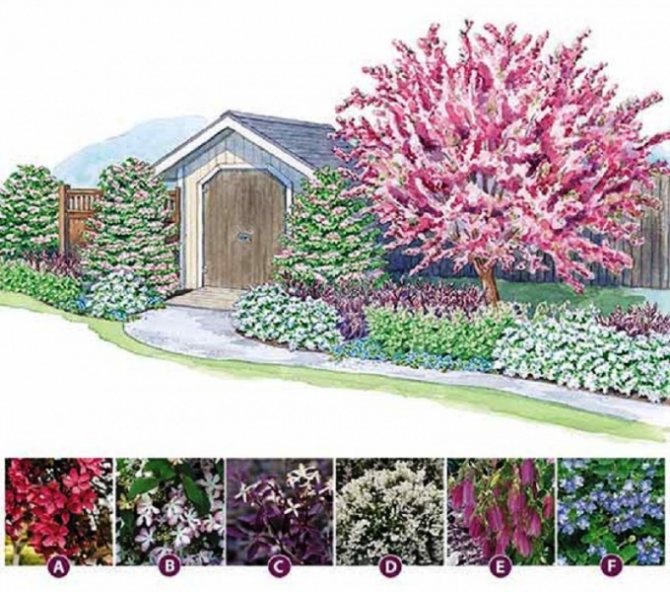

- For the improvement of the path to the garden, you can choose a flower bed scheme of juniper, mountaineer, sage, cinquefoil, helenium and formium.
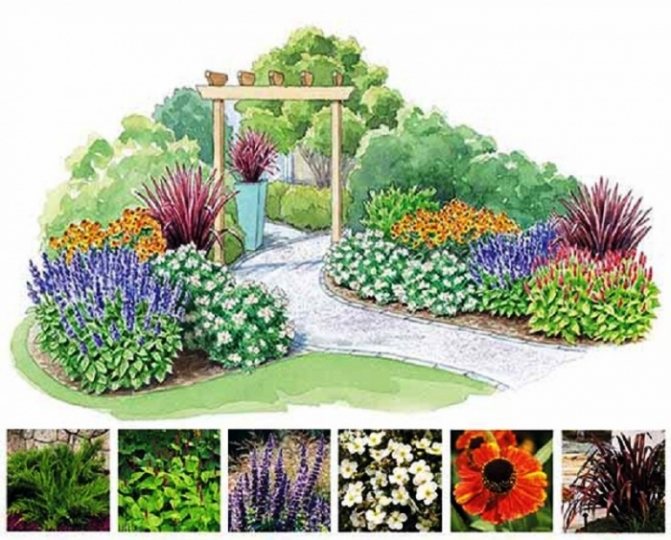

Features of ripening and flowering of annuals
When buying annual seeds, you need to tune in to the fact that your flower bed will bloom no earlier than mid-May, even if you grow seedlings at home, on the windowsills. With direct sowing in the ground, the plants will bloom even later - by June. And the reason is not only that most annuals give their first flowers 40-45 days after seed germination. The rate of maturation of plants will also be influenced by the weather. If May turns out to be cold, in frost, then the sprouted sprouts will be easily damaged, stop growing, and their growing season will increase. Even the most unpretentious marigolds do not like the contrasts of night and day temperatures. Therefore, gardeners have an unspoken rule: to plant seedlings only after the end of the May frosts, and if they were sown directly into the ground, then cover them with spunbond or other non-woven material at night.
Types of flower beds and choice of location
The place for the flower garden is determined based on its shape. A flower bed in the country can take on various shapes, the following types are most common:
- The flower border along the path is formed from undersized flowers.


- Rabatka is a rectangular flower bed decorated with plants of the same height.
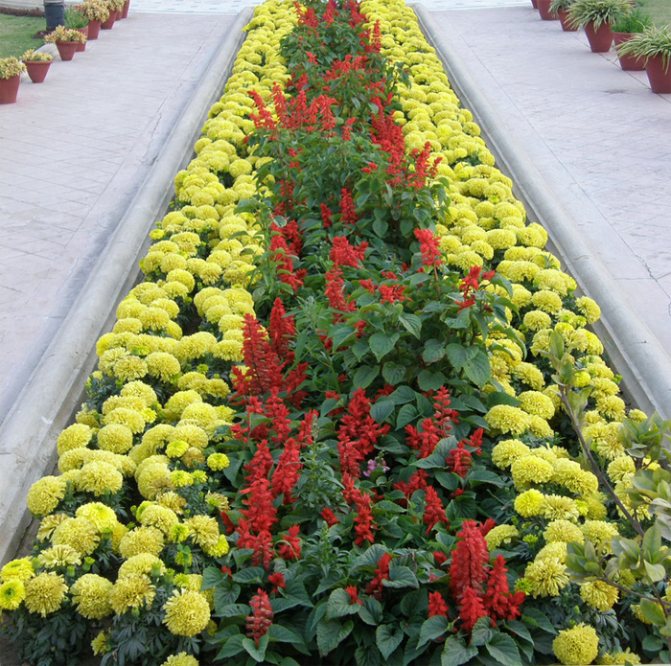

- Mixborder is a popular solution for decorating a summer cottage in recent years. The arbitrary shape of the flower bed, coupled with plants of various heights, gives unlimited freedom of imagination when drawing up diagrams. Mixborder is a striking representative of continuous flowering beds, successfully forming a cozy atmosphere in the country.
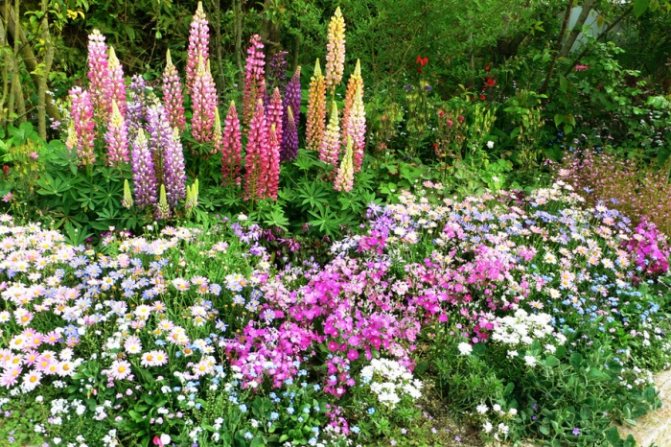

- Another leader among the variety of flower plantations is an alpine slide, a distinctive feature of which is the presence of stones in the design. Basically, it takes on a round or oval shape.


- Less common is a mono flower garden, consisting of one type of plant.
- The vertical flowerbed, which requires professional care, is distinguished by its originality.
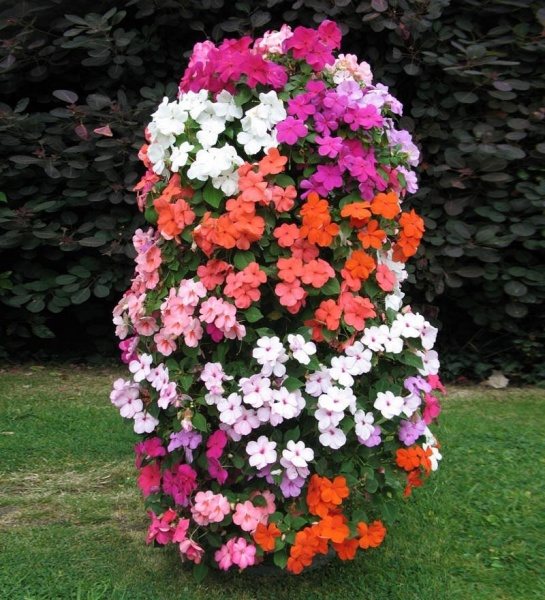

- Experienced gardeners should think about the formation of an arabesque in the country. The butterfly shape is the most common type of flower bed that needs a planting scheme.
With a competent drawing up of a flower garden scheme, even primitive plantings can look spectacular and attract admiring glances. When choosing a flower bed scheme, it is preferable for beginners to stop at irregular flower beds, such as a mixborder or an alpine slide. The accumulated experience will allow in the future to start decorating regular flower beds at the dacha, where a strict geometric pattern is achieved by selecting plants with the same flowering time and observing a certain interval between planting.
A variant of a mixborder made of thuja, David's buddley, zinnia, goldenrod and purple echinacea will help to attract butterflies.
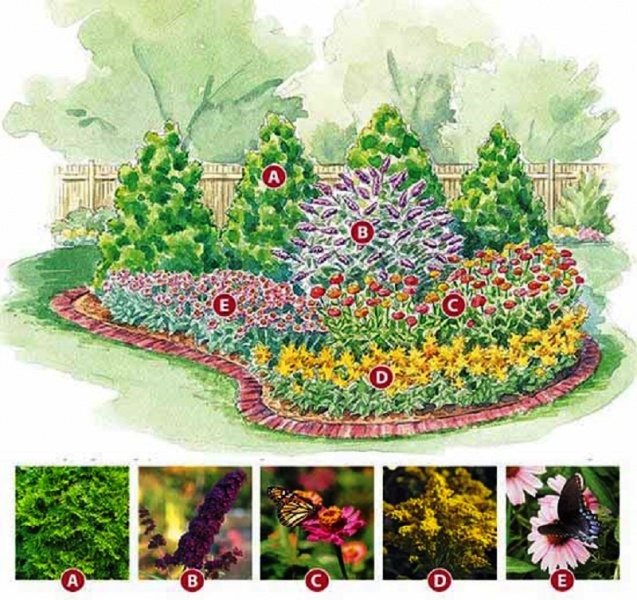

The optimal place for a flower garden is a plot that is well visible from all sides of the summer cottage. Multi-level plantings are usually arranged near walls or a fence, an arabesque flower bed will become an original decoration of the lawn, it is better for beginners to practice on an alpine slide.
Comment! Shaded and well-lit places are marked on it when forming a flower bed scheme for a certain area in the country. This will help to properly complement the flower garden, providing the plants with optimal conditions for development.


Mixborder scheme with photo
With all the splendor of the strict lines, the ridges in a private courtyard are more appropriate, it seems to us, and they are more popular. mixborders - flower beds, the stylistic features of which are included in the name. “Mix” - dissimilar plants are used for registration: perennials and annuals, of different heights, outwardly dissimilar, blooming at different times of the season. "Border" - characterizes the peculiarities of the location of the flower garden: along alleys, buildings, around lawns, etc. As a rule, mixborders are much easier to set up and look "livelier" in comparison with a refined rabatka.
When planning plantings of different heights, you can use the correct rule, according to which the tallest plants are in the middle (or at the far edge, if the flower garden is located, say, near a wall), the lowest are on the edge, like rounded, bushy ones.
Read also Planting potatoes: preparation, processing, methods, full instructions
Flower bed preparation
To calculate the required number of seedlings, the flower garden scheme is divided into squares with a conditional side of 1 m.After that, the area occupied by each species is calculated. The resulting value is divided by the average planting rate per 1 m2:
- large stands with a height of 1.0-1.2 m - 2-3 pcs.;
- medium-sized flowers from 40 to 90 cm high, 4-6 pieces are enough;
- with a plant height of 20-40 cm, 7-9 specimens are planted in a flower garden per 1 m2;
- for dwarf flowers from 5 to 20 cm, the norm is 16-20 pcs.
To transfer the flower bed scheme to the dacha site, the contours of the planting are marked with sawdust, sand or chalk. Before that, the earth is dug to a depth of 0.4 m, all weed roots and the top layer of sod are removed. Specially prepared soil is poured on top for the flower garden.
An example of a successful decoration of the entrance to the dacha is presented in the following diagram, where roses, petunias, thuja, delphinium, lilies, asters and a cuff are used in the design of the flower beds:
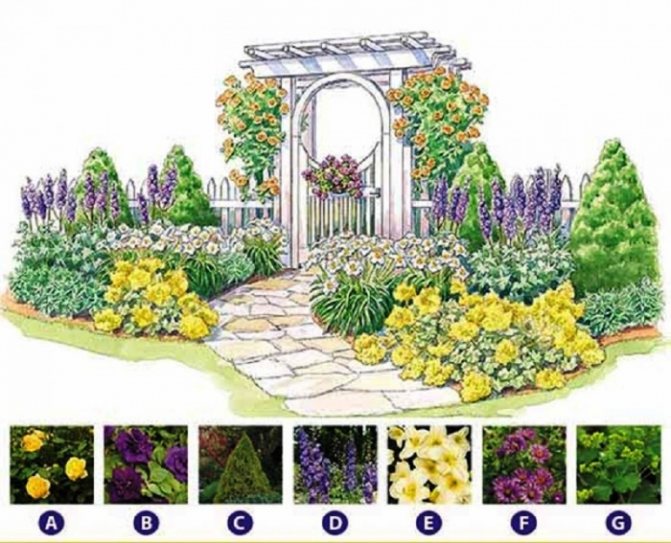

Decor that allows you to create an original solution for flower beds
According to the design rules, flower beds and flower beds can be decorated with various decorative elements. To create a central decor around which a flower bed will be created, the following details are used: drinkers for birds, stone balls, sundials, driftwood, logs, stumps, wheels, carts, mirrors, arches, sculptures, plants trimmed in the form of different shapes.
In addition to the central figure, one must not forget about fences, lighting, stones of different colors. All these elements make it possible to emphasize the unusual shape of the flower bed or to highlight any plant against the background of the rest.
General recommendations for planting plants
Before planting in a flower garden, seedlings need preliminary watering in 2-3 hours. The optimal time for disembarking in the country is the absence of a bright sun, that is, in the early morning or at the end of the day. Better yet, choose a period before the rain. A flower garden of a round shape is filled from the center to the edges, a flower bed located near the fence of a summer cottage or building begins to be decorated from the background according to the chosen scheme.
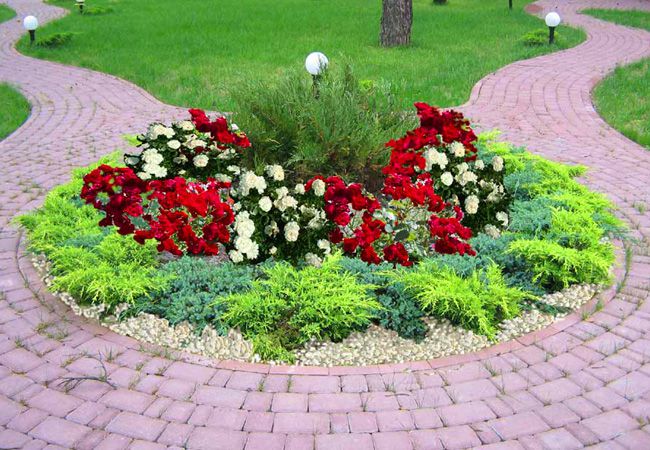

The roots of the seedlings are straightened, after deepening, the soil near the neck of the plant is compacted. Upon completion of the work, the flower garden is abundantly watered, tall weak seedlings are propped up with a stick. If a flower does not take root, it can be replaced at any time with a new copy from a pot. Do not expect the perfect appearance of a perennial flower garden in the country in the first year of the breakdown.
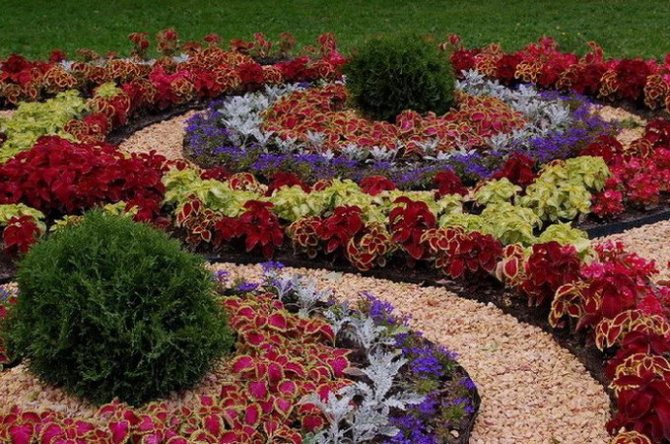

Advice! The unattractive voids of the flower beds are temporarily filled with annual flowers that are suitable for the conditions of detention with the entire scheme.
A fragrant flower garden made of hibiscus, kufei, penstemon, vatnik and petunia looks interesting, the diagram of which is given below:
Do not be afraid to make adjustments to the existing flower bed scheme. Replacing one type with another, similar in content, changing the shape or area is only welcome.
Flower bed - pencil drawings for children for sketching: photo
Drawing is extremely useful for children of any age, as it develops:
- fine motor skills
- fantasy
- Creative skills
- attention to detail
- perception of objects in all their brightness and completeness
In addition, the process of depicting the surrounding world is a fascinating and interesting activity. But some children refuse to draw complex things for fear of failure. Wake up your child's interest in drawing and self-confidence using our tips:
- ask the kid what flowers he wants to depict in his flower bed
- teach him to draw a flower from the middle, and then draw a stalk with leaves
- explain that when coloring a drawing, paint or pencil strokes should not go beyond the outline
- finish work when you see that the child has lost interest in the activity. Don't make him draw if he doesn't want to
- praise his work and hang the drawing in a conspicuous place so that the kid knows that you like the result of his work
And to make it easier for a young artist to draw a flower bed, we offer several options for sketching.
Design Tips
In addition to the flowering period, when forming a flower garden scheme for a summer residence, the requirements of plants for soil acidity, lighting conditions, as well as their height are taken into account.


The group of low-growing plants contains unpretentious bulbous specimens: hyacinths, snowdrops, crocuses and muscari. For beginners, as perennials for a flower bed scheme, you can advise felt chickweed, subulate phlox and primrose. The dacha will also be decorated with bright biennials in the form of daisies, forget-me-nots and pansies. Annual representatives of the flora in the form of undersized marigolds, petunias, purslane are able to organically complement the flower garden scheme.
Flowers of medium height are the basic basis of a garden cottage, therefore, for the scheme, it is preferable to choose specimens with a special decorative effect. These conditions are met by such perennials:
- daylilies;
- peonies;
- chamomile;
- lilies;
- irises;
- bells;
- phlox;
- hosts.
Annual species will help to fill the voids in a new flowerbed in the country: marigolds, asters, lavatera and salvia. In the background or in the center of the flower bed, a place for tall plants is assigned in the scheme. For these purposes, aconite, ornamental sunflower, clary sage, delphinium, lupine are suitable.


The shaded areas of the summer cottage will be decorated with flower beds with Japanese anemones, stonecrop, hosts of all kinds of colors of flowers and leaves, ferns, common primrose and dark geranium. A summer cottage with acidic soil is a great place to decorate a flower garden with hydrangea, rhododendron, fern. The flower bed scheme can also include herbal cloves, heather, canadian dogwood, broom, or bergus.
- Harmony emanates from the scheme of the flower bed near the house, consisting of virginia, rose, sedum, balsam, woolly and Chinese miscanthus.
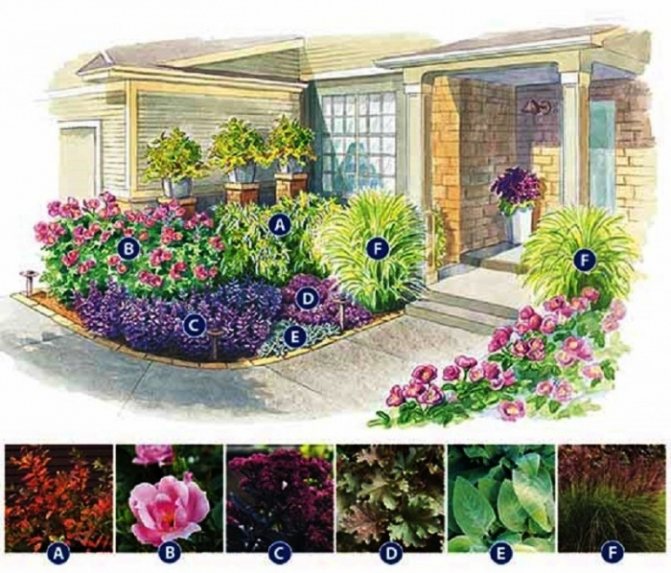

- The decoration of any path will be a flower bed, the scheme of which includes a plantarium, coreopsis, petunia, creeping tenacious:
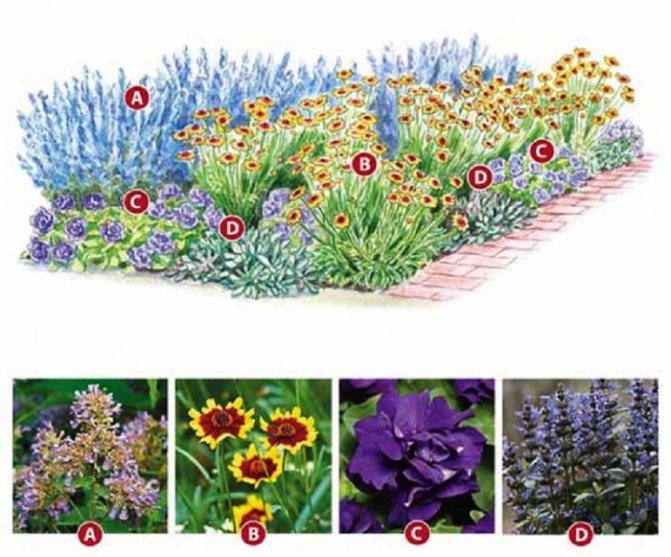

The first steps. Size and shape
The main difference between a flower bed and a flower garden is its shape. If the flower garden can have absolutely any shape that you want, then the flower bed is made only in strict geometrical configurations (circle, oval, rectangle, square). It can be any geometric figure, but with smooth and clear contours.
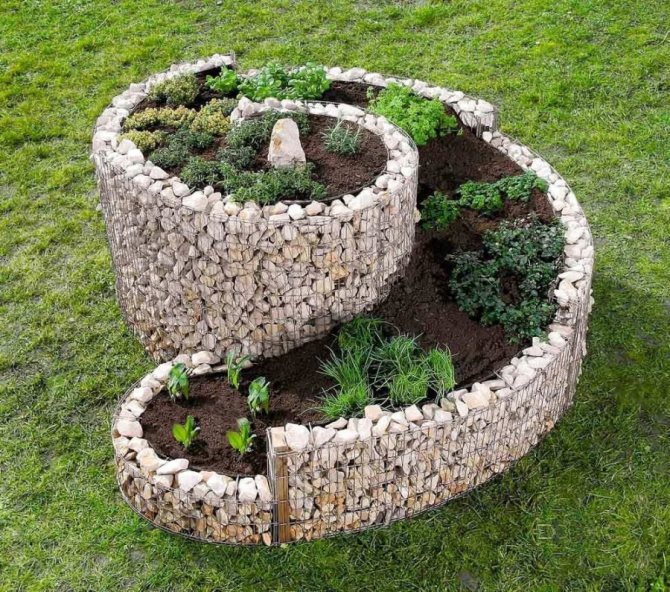

Beds with a distinct geometry look more attractive on a smooth, well-groomed lawn. It is worth noting that the shape of the flower garden should be visible from each side, otherwise it will look sloppy.
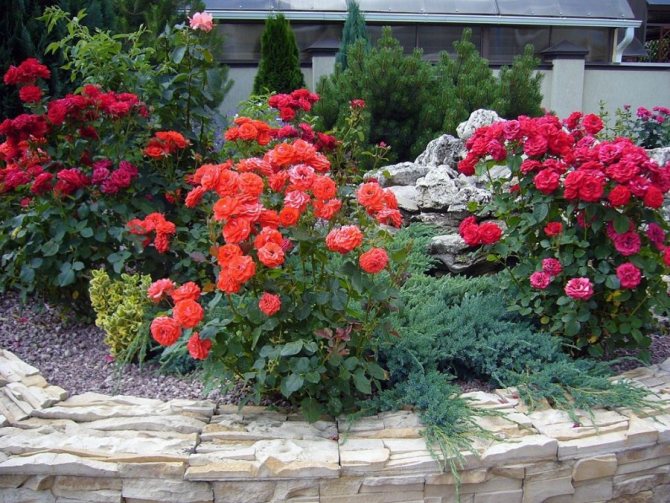

In order to prevent such a situation, it is recommended to pay attention to two important points.
The first is a diagram of the future composition. The process of its creation is quite simple, it is necessary to draw the outline of the planned object on the prepared site.
The second point is the planting density. Here you should take into account the peculiarities of their growth when using several different varieties. For example, the planting of identical plants must be done according to the "carpet" principle, placed extremely close to each other.


If empty areas remain among the flowers, this will violate all the showiness and spoil the geometric integrity. You can see the options for the beautiful design of a flower bed by the type of "carpet" in the photo.
The dimensions and shape of the future flower bed completely depend on the size of the site itself. If there is an opportunity to create a large front garden, then you should take advantage of this. After all, massive flower arrangements have a more attractive appearance in contrast to small islands.
If you are not an experienced gardener, then as a first experience, make it a simple shape with an unpretentious design.


Medium-sized flowers blooming all summer


Dahlias
This variety of dahlias has the second popular name for flowers for a flower bed that blooms all summer long - "funny guys". These flowers look great along paths, can create hedges, are sown directly into the ground and require no maintenance. Moreover, they have a very wide variety of shades that summer residents like.


Lupins
Many do not like these flowers, considering them weeds, for their ability to quickly grow over the site. But if it is easy for you to control this process or you have large territories where you do not know what to plant, then lupins are perfect. They are unpretentious, have delicate blue, lilac, pink tones. Flowers is a candlestick. Lupines also have beautiful greens.
Zinnias
Very beautiful flowers that can also be planted next to the curb. Zinnias have an unusual appearance, a wide variety of catchy and juicy shades. They bloom all summer and at certain times attract butterflies very much, which gives the site a special comfort.
These are the flowers you can plant this season. They will create a beautiful floral carpet that will be dotted with flowers all summer long, delighting you and your family.
DIY flower bed design in the country photo
The tastefully arranged front garden on the plot is not one on which all sorts of attractive plants are scattered. Their excess will lead to a deterioration in development, and it can also lose its decorative individuality.
Having shown imagination, you can use old things to decorate and create an original flower bed design by making it yourself. Here are some photo ideas and interesting design solutions for beginners:
The abandoned fountain was decorated with perennial plants and succulents.
A blooming bed looks good, complemented by an old jug or an old barrel, from which flowers also bloom, it seems that they poured out of the vessel:
Cart with flowers. You can use an old garden cart, or you can assemble a decorative wooden cart with your own hands:
An interesting, but at the same time very simple idea of planting flowers in the form of a pot on fire. You can simulate fire using any blooming red and orange flowers. The idea is that such a decoration of a summer cottage does not take up much space and reminds of a pleasant vacation with family in nature, and the smell of delicious fish soup on the fire will replace the aroma of beautiful flowers:

